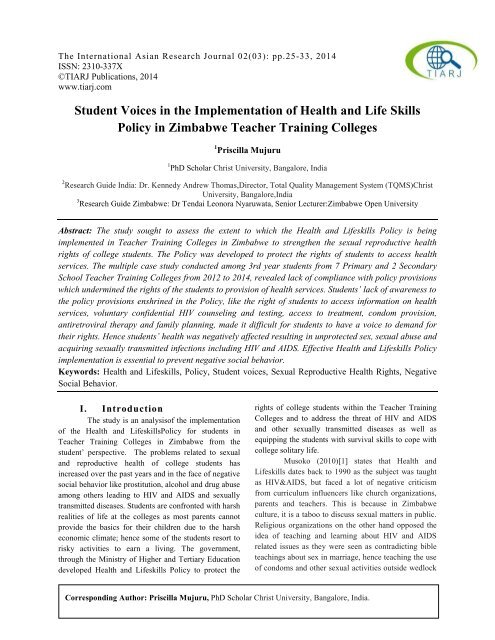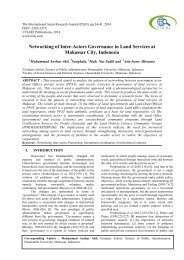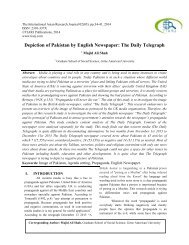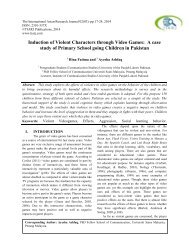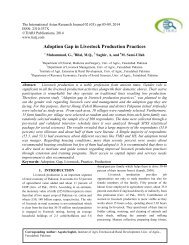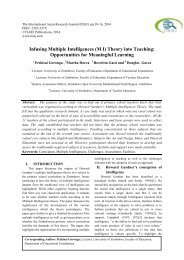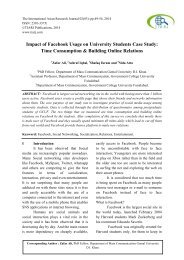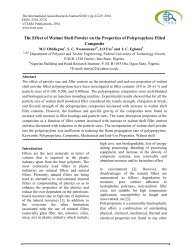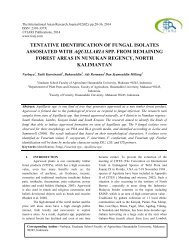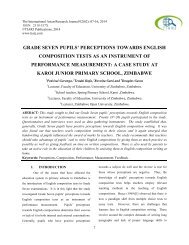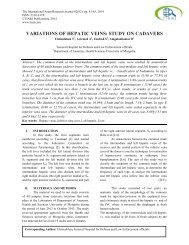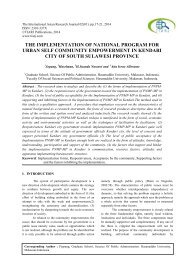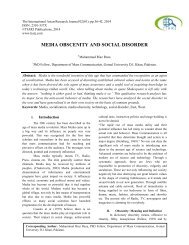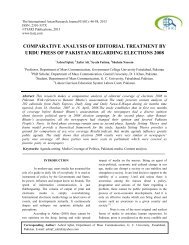Student Voices in the Implementation of Health and Lifeskills Policy in Zimbabwe Teacher Training Colleges. By: Priscilla Mujuru
Create successful ePaper yourself
Turn your PDF publications into a flip-book with our unique Google optimized e-Paper software.
The International Asian Research Journal 02(03): pp.25-33, 2014<br />
ISSN: 2310-337X<br />
©TIARJ Publications, 2014<br />
www.tiarj.com<br />
<strong>Student</strong> <strong>Voices</strong> <strong>in</strong> <strong>the</strong> <strong>Implementation</strong> <strong>of</strong> <strong>Health</strong> <strong>and</strong> Life Skills<br />
<strong>Policy</strong> <strong>in</strong> <strong>Zimbabwe</strong> <strong>Teacher</strong> Tra<strong>in</strong><strong>in</strong>g <strong>Colleges</strong><br />
1 <strong>Priscilla</strong> <strong>Mujuru</strong><br />
1 PhD Scholar Christ University, Bangalore, India<br />
2 Research Guide India: Dr. Kennedy Andrew Thomas,Director, Total Quality Management System (TQMS)Christ<br />
University, Bangalore,India<br />
3 Research Guide <strong>Zimbabwe</strong>: Dr Tendai Leonora Nyaruwata, Senior Lecturer:<strong>Zimbabwe</strong> Open University<br />
Abstract: The study sought to assess <strong>the</strong> extent to which <strong>the</strong> <strong>Health</strong> <strong>and</strong> <strong>Lifeskills</strong> <strong>Policy</strong> is be<strong>in</strong>g<br />
implemented <strong>in</strong> <strong>Teacher</strong> Tra<strong>in</strong><strong>in</strong>g <strong>Colleges</strong> <strong>in</strong> <strong>Zimbabwe</strong> to streng<strong>the</strong>n <strong>the</strong> sexual reproductive health<br />
rights <strong>of</strong> college students. The <strong>Policy</strong> was developed to protect <strong>the</strong> rights <strong>of</strong> students to access health<br />
services. The multiple case study conducted among 3rd year students from 7 Primary <strong>and</strong> 2 Secondary<br />
School <strong>Teacher</strong> Tra<strong>in</strong><strong>in</strong>g <strong>Colleges</strong> from 2012 to 2014, revealed lack <strong>of</strong> compliance with policy provisions<br />
which underm<strong>in</strong>ed <strong>the</strong> rights <strong>of</strong> <strong>the</strong> students to provision <strong>of</strong> health services. <strong>Student</strong>s’ lack <strong>of</strong> awareness to<br />
<strong>the</strong> policy provisions enshr<strong>in</strong>ed <strong>in</strong> <strong>the</strong> <strong>Policy</strong>, like <strong>the</strong> right <strong>of</strong> students to access <strong>in</strong>formation on health<br />
services, voluntary confidential HIV counsel<strong>in</strong>g <strong>and</strong> test<strong>in</strong>g, access to treatment, condom provision,<br />
antiretroviral <strong>the</strong>rapy <strong>and</strong> family plann<strong>in</strong>g, made it difficult for students to have a voice to dem<strong>and</strong> for<br />
<strong>the</strong>ir rights. Hence students’ health was negatively affected result<strong>in</strong>g <strong>in</strong> unprotected sex, sexual abuse <strong>and</strong><br />
acquir<strong>in</strong>g sexually transmitted <strong>in</strong>fections <strong>in</strong>clud<strong>in</strong>g HIV <strong>and</strong> AIDS. Effective <strong>Health</strong> <strong>and</strong> <strong>Lifeskills</strong> <strong>Policy</strong><br />
implementation is essential to prevent negative social behavior.<br />
Keywords: <strong>Health</strong> <strong>and</strong> <strong>Lifeskills</strong>, <strong>Policy</strong>, <strong>Student</strong> voices, Sexual Reproductive <strong>Health</strong> Rights, Negative<br />
Social Behavior.<br />
I. Introduction<br />
The study is an analysis<strong>of</strong> <strong>the</strong> implementation<br />
<strong>of</strong> <strong>the</strong> <strong>Health</strong> <strong>and</strong> <strong>Lifeskills</strong><strong>Policy</strong> for students <strong>in</strong><br />
<strong>Teacher</strong> Tra<strong>in</strong><strong>in</strong>g <strong>Colleges</strong> <strong>in</strong> <strong>Zimbabwe</strong> from <strong>the</strong><br />
student’ perspective. The problems related to sexual<br />
<strong>and</strong> reproductive health <strong>of</strong> college students has<br />
<strong>in</strong>creased over <strong>the</strong> past years <strong>and</strong> <strong>in</strong> <strong>the</strong> face <strong>of</strong> negative<br />
social behavior like prostitution, alcohol <strong>and</strong> drug abuse<br />
among o<strong>the</strong>rs lead<strong>in</strong>g to HIV <strong>and</strong> AIDS <strong>and</strong> sexually<br />
transmitted diseases. <strong>Student</strong>s are confronted with harsh<br />
realities <strong>of</strong> life at <strong>the</strong> colleges as most parents cannot<br />
provide <strong>the</strong> basics for <strong>the</strong>ir children due to <strong>the</strong> harsh<br />
economic climate; hence some <strong>of</strong> <strong>the</strong> students resort to<br />
risky activities to earn a liv<strong>in</strong>g. The government,<br />
through <strong>the</strong> M<strong>in</strong>istry <strong>of</strong> Higher <strong>and</strong> Tertiary Education<br />
developed <strong>Health</strong> <strong>and</strong> <strong>Lifeskills</strong> <strong>Policy</strong> to protect <strong>the</strong><br />
rights <strong>of</strong> college students with<strong>in</strong> <strong>the</strong> <strong>Teacher</strong> Tra<strong>in</strong><strong>in</strong>g<br />
<strong>Colleges</strong> <strong>and</strong> to address <strong>the</strong> threat <strong>of</strong> HIV <strong>and</strong> AIDS<br />
<strong>and</strong> o<strong>the</strong>r sexually transmitted diseases as well as<br />
equipp<strong>in</strong>g <strong>the</strong> students with survival skills to cope with<br />
college solitary life.<br />
Musoko (2010)[1] states that <strong>Health</strong> <strong>and</strong><br />
<strong>Lifeskills</strong> dates back to 1990 as <strong>the</strong> subject was taught<br />
as HIV&AIDS, but faced a lot <strong>of</strong> negative criticism<br />
from curriculum <strong>in</strong>fluencers like church organizations,<br />
parents <strong>and</strong> teachers. This is because <strong>in</strong> <strong>Zimbabwe</strong><br />
culture, it is a taboo to discuss sexual matters <strong>in</strong> public.<br />
Religious organizations on <strong>the</strong> o<strong>the</strong>r h<strong>and</strong> opposed <strong>the</strong><br />
idea <strong>of</strong> teach<strong>in</strong>g <strong>and</strong> learn<strong>in</strong>g about HIV <strong>and</strong> AIDS<br />
related issues as <strong>the</strong>y were seen as contradict<strong>in</strong>g bible<br />
teach<strong>in</strong>gs about sex <strong>in</strong> marriage, hence teach<strong>in</strong>g <strong>the</strong> use<br />
<strong>of</strong> condoms <strong>and</strong> o<strong>the</strong>r sexual activities outside wedlock<br />
Correspond<strong>in</strong>g Author: <strong>Priscilla</strong> <strong>Mujuru</strong>, PhD Scholar 25 Christ University, Bangalore, India.
The International Asian Research Journal 02(03): pp.25-33, 2014<br />
was found to be immoral practice which was totally<br />
unacceptable. <strong>Teacher</strong>s as curriculum implementers<br />
regarded teach<strong>in</strong>g <strong>of</strong> HIV <strong>and</strong> AIDS alone as not<br />
enough for behavioural change towards reduc<strong>in</strong>g <strong>the</strong><br />
spread <strong>of</strong> HIV <strong>in</strong> <strong>the</strong> <strong>Zimbabwe</strong>an Society. Therefore<br />
<strong>the</strong> curriculum designers complied with <strong>the</strong> needs <strong>and</strong><br />
expectations <strong>of</strong> <strong>the</strong> society to widen <strong>and</strong> change <strong>the</strong><br />
subject to <strong>Health</strong> <strong>and</strong> <strong>Lifeskills</strong>. Rousseau(1712 –<br />
1778), <strong>the</strong> pioneer <strong>of</strong> child education, advocates that<br />
children must learn from <strong>the</strong>ir immediate environment<br />
<strong>and</strong> should be aware <strong>of</strong> all community issues <strong>and</strong> learn<br />
how to solve community challenges through embark<strong>in</strong>g<br />
on community projects. This led to <strong>the</strong> birth <strong>of</strong> <strong>Health</strong><br />
<strong>and</strong> <strong>Lifeskills</strong>.<br />
The study analyzed <strong>the</strong> effectiveness <strong>of</strong> <strong>the</strong><br />
implementation <strong>of</strong> <strong>the</strong> <strong>Health</strong> <strong>and</strong> <strong>Lifeskills</strong> policy <strong>in</strong><br />
colleges <strong>in</strong> relation to students’ sexual <strong>and</strong> reproductive<br />
health, more than 6 years after it was developed.<br />
Accord<strong>in</strong>g to <strong>the</strong> <strong>Zimbabwe</strong> Demographic <strong>and</strong> <strong>Health</strong><br />
Survey (2010 – 2011) [2], <strong>the</strong> age at first sexual<br />
<strong>in</strong>tercourse can be used as a proxy to <strong>the</strong> beg<strong>in</strong>n<strong>in</strong>g <strong>of</strong><br />
exposure to <strong>the</strong> risk <strong>of</strong> pregnancy. The median age at<br />
first sexual <strong>in</strong>tercourse for women aged 25 – 49 is 18.9<br />
years while for men <strong>of</strong> <strong>the</strong> same age group is 20.6<br />
years. <strong>By</strong> age <strong>of</strong> 20, about six <strong>in</strong> ten <strong>Zimbabwe</strong>an<br />
women have had sexual <strong>in</strong>tercourse while men exhibit a<br />
slightly older median age <strong>of</strong> 20.6years. This age range<br />
is <strong>the</strong> age group <strong>in</strong> which <strong>the</strong> college students fall <strong>in</strong>to.<br />
Sexuality education activities are guided by <strong>the</strong> Sexual<br />
Reproductive <strong>Health</strong> (2010 - 2015)[3] which <strong>of</strong>fers<br />
three approaches to address<strong>in</strong>g SRH issues <strong>of</strong> young<br />
people – health facility based approach; school based<br />
approach <strong>and</strong> community based approach. In<br />
<strong>Zimbabwe</strong>an schools, health <strong>and</strong> <strong>Lifeskills</strong> education is<br />
compulsory <strong>in</strong> all primary <strong>and</strong> secondary schools <strong>and</strong><br />
tertiary <strong>in</strong>stitutions, <strong>and</strong> HIV <strong>and</strong> AIDS is <strong>in</strong>tegrated<br />
<strong>in</strong>to relevant subjects. The research questions guid<strong>in</strong>g<br />
this study focused on <strong>the</strong> extent to which <strong>the</strong> <strong>Health</strong> <strong>and</strong><br />
<strong>Lifeskills</strong> policy is be<strong>in</strong>g implemented <strong>in</strong> <strong>Teacher</strong><br />
Tra<strong>in</strong><strong>in</strong>g <strong>Colleges</strong>; what HIV/AIDS services are be<strong>in</strong>g<br />
provided to pre-service teachers; <strong>the</strong> constra<strong>in</strong>ts faced<br />
by <strong>the</strong> teacher tra<strong>in</strong><strong>in</strong>g <strong>in</strong>stitutions to implement <strong>the</strong><br />
<strong>Health</strong> <strong>and</strong> <strong>Lifeskills</strong> <strong>Policy</strong> <strong>and</strong> how <strong>the</strong>se can be<br />
overcome to streng<strong>the</strong>n teacher tra<strong>in</strong><strong>in</strong>g <strong>and</strong> better<br />
prepare teachers to deliver effective <strong>Health</strong> <strong>and</strong><br />
<strong>Lifeskills</strong> education.<br />
1. Methodology:<br />
The multiple case study design was used for<br />
this study between 2012 <strong>and</strong> 2014. The study<br />
population was composed <strong>of</strong> 3 rd year exit students from<br />
7 <strong>Teacher</strong> Tra<strong>in</strong><strong>in</strong>g <strong>Colleges</strong> which prepare students for<br />
teach<strong>in</strong>g <strong>in</strong> both primary <strong>and</strong> secondary schools. The<br />
college <strong>in</strong>takes were different based on <strong>the</strong> size <strong>of</strong> <strong>the</strong><br />
college, hence <strong>the</strong> samples <strong>of</strong> <strong>the</strong> students were also<br />
proportional to <strong>the</strong> size <strong>of</strong> <strong>the</strong> <strong>in</strong>take.<br />
This group was selected realiz<strong>in</strong>g that <strong>the</strong>y are at <strong>the</strong><br />
po<strong>in</strong>t <strong>of</strong> exit<strong>in</strong>g <strong>the</strong> colleges after exposure to all <strong>the</strong><br />
education on health <strong>and</strong> <strong>Lifeskills</strong>. The student sample<br />
was selected us<strong>in</strong>g <strong>the</strong> convenient sampl<strong>in</strong>g method.<br />
Questionnaires were distributed to a total <strong>of</strong> 900<br />
students <strong>and</strong> 16 focus group discussions were done (two<br />
per college - one with a group <strong>of</strong> women <strong>and</strong> <strong>the</strong> o<strong>the</strong>r<br />
with a group <strong>of</strong> men). This enabled <strong>the</strong> students to be as<br />
open as possible without <strong>the</strong> element <strong>of</strong> shame or fear<br />
<strong>of</strong> ridicule. The f<strong>in</strong>d<strong>in</strong>gs <strong>in</strong> this article <strong>in</strong>clude issues<br />
that were raised through <strong>the</strong> focus group discussions<br />
<strong>and</strong> <strong>the</strong> questionnaires.<br />
II. THEORETICAL FRAMEWORK<br />
The study was based on <strong>the</strong> constructivist<br />
<strong>the</strong>oretical framework which focuses on <strong>the</strong> shift from<br />
<strong>the</strong> teacher to <strong>the</strong> students. The concept <strong>of</strong><br />
constructivism has roots <strong>in</strong> classical antiquity, go<strong>in</strong>g<br />
back to Socrates's dialogues with his followers, <strong>in</strong><br />
which he asked directed questions that led his students<br />
to realize for <strong>the</strong>mselves <strong>the</strong> weaknesses <strong>in</strong> <strong>the</strong>ir<br />
th<strong>in</strong>k<strong>in</strong>g. The Socratic dialogue is still an important tool<br />
<strong>in</strong> <strong>the</strong> way constructivist educators assess <strong>the</strong>ir students'<br />
learn<strong>in</strong>g <strong>and</strong> plan new learn<strong>in</strong>g experiences.<br />
In <strong>the</strong> constructivist model, <strong>the</strong> students are urged to be<br />
actively <strong>in</strong>volved <strong>in</strong> <strong>the</strong>ir own process <strong>of</strong> learn<strong>in</strong>g. The<br />
teacher functions more as a facilitator who coaches,<br />
mediates, prompts, <strong>and</strong> helps students develop <strong>and</strong><br />
assess <strong>the</strong>ir underst<strong>and</strong><strong>in</strong>g, <strong>and</strong> <strong>the</strong>reby <strong>the</strong>ir learn<strong>in</strong>g.<br />
One <strong>of</strong> <strong>the</strong> teacher's biggest jobs becomes ask<strong>in</strong>g good<br />
questions. Both teacher <strong>and</strong> students th<strong>in</strong>k <strong>of</strong><br />
knowledge not as <strong>in</strong>ert factoids to be memorized, but as<br />
a dynamic, ever-chang<strong>in</strong>g view <strong>of</strong> <strong>the</strong> world we live <strong>in</strong><br />
<strong>and</strong> <strong>the</strong> ability to successfully stretch <strong>and</strong> explore that<br />
view. Curriculum emphasizes big concepts, beg<strong>in</strong>n<strong>in</strong>g<br />
with <strong>the</strong> whole <strong>and</strong> exp<strong>and</strong><strong>in</strong>g to <strong>in</strong>clude <strong>the</strong><br />
parts.Pursuit <strong>of</strong> student questions <strong>and</strong> <strong>in</strong>terests is<br />
valued. Materials <strong>in</strong>clude primary sources <strong>of</strong> material<br />
<strong>and</strong> manipulative materials. <strong>Teacher</strong>'s role is<br />
<strong>in</strong>teractive, rooted <strong>in</strong> negotiation. Assessment <strong>in</strong>cludes<br />
student works, observations, <strong>and</strong> po<strong>in</strong>ts <strong>of</strong> view, as well<br />
as tests. Process is as important as product. Knowledge<br />
is seen as dynamic, ever chang<strong>in</strong>g with our experiences.<br />
26
The International Asian Research Journal 02(03): pp.25-33, 2014<br />
<strong>Student</strong>s work primarily <strong>in</strong> groups. Constructivist<br />
teachers pose questions <strong>and</strong> problems, <strong>the</strong>n guide<br />
students to help <strong>the</strong>m f<strong>in</strong>d <strong>the</strong>ir own answers. They use<br />
many techniques <strong>in</strong> <strong>the</strong> teach<strong>in</strong>g process. For example,<br />
<strong>the</strong>y may:<br />
prompt students to formulate <strong>the</strong>ir own<br />
questions (<strong>in</strong>quiry)<br />
allow multiple <strong>in</strong>terpretations <strong>and</strong> expressions<br />
<strong>of</strong> learn<strong>in</strong>g (multiple <strong>in</strong>telligences)<br />
encourage group work <strong>and</strong> <strong>the</strong> use <strong>of</strong> peers as<br />
resources (collaborative learn<strong>in</strong>g)<br />
It is important to realize that <strong>the</strong> constructivist<br />
approach borrows from many o<strong>the</strong>r practices <strong>in</strong> <strong>the</strong><br />
pursuit <strong>of</strong> its primary goal: help<strong>in</strong>g students learn how<br />
to learn. <strong>Student</strong>s are not blank slates upon which<br />
knowledge is etched. They come to learn<strong>in</strong>g situations<br />
with already formulated knowledge, ideas, <strong>and</strong><br />
underst<strong>and</strong><strong>in</strong>gs. This previous knowledge is <strong>the</strong> raw<br />
material for <strong>the</strong> new knowledge <strong>the</strong>y will create.The<br />
student is <strong>the</strong> person who creates new underst<strong>and</strong><strong>in</strong>g for<br />
him/herself. The teacher coaches, moderates, suggests,<br />
but allows <strong>the</strong> students room to experiment, ask<br />
questions, try th<strong>in</strong>gs that don't work. Learn<strong>in</strong>g activities<br />
require <strong>the</strong> students' full participation (like h<strong>and</strong>s -on<br />
experiments). An important part <strong>of</strong> <strong>the</strong> learn<strong>in</strong>g process<br />
is that students reflect on, <strong>and</strong> talk about, <strong>the</strong>ir<br />
activities.<br />
<strong>Student</strong>s also help set <strong>the</strong>ir own goals <strong>and</strong><br />
means <strong>of</strong> assessment. Examples: In <strong>Health</strong> <strong>and</strong><br />
<strong>Lifeskills</strong> education, ask<strong>in</strong>g students to read <strong>and</strong> th<strong>in</strong>k<br />
about different versions <strong>of</strong> <strong>and</strong> perspectives on HIV <strong>and</strong><br />
AIDS can lead to <strong>in</strong>terest<strong>in</strong>g discussions. Is HIV <strong>and</strong><br />
AIDS as taught <strong>in</strong> textbooks accurate? Are <strong>the</strong>re<br />
different versions <strong>of</strong> <strong>the</strong> same problem? Whose version<br />
<strong>of</strong> <strong>the</strong> orig<strong>in</strong> <strong>of</strong> HIV is most accurate? How do we<br />
know? From <strong>the</strong>re, students can make <strong>the</strong>ir own<br />
judgments, control <strong>the</strong>ir own learn<strong>in</strong>g process, <strong>and</strong> lead<br />
<strong>the</strong> way by reflect<strong>in</strong>g on <strong>the</strong>ir experiences. This process<br />
makes <strong>the</strong>m experts <strong>of</strong> <strong>the</strong>ir own learn<strong>in</strong>g. The teacher<br />
helps create situations where <strong>the</strong> students feel safe<br />
question<strong>in</strong>g <strong>and</strong> reflect<strong>in</strong>g on <strong>the</strong>ir own processes,<br />
ei<strong>the</strong>r privately or <strong>in</strong> group discussions. The teacher<br />
should also create activities that lead <strong>the</strong> student to<br />
reflect on his or her prior knowledge <strong>and</strong> experiences.<br />
Talk<strong>in</strong>g about what was learned <strong>and</strong> how it was learned<br />
is really important. College students will be expected to<br />
be creative when <strong>the</strong>y leave college to teach pupils <strong>in</strong><br />
<strong>the</strong> respective schools that <strong>the</strong>y will be expected to go<br />
to.<br />
Constructivism relies heavily on collaboration<br />
among students hence <strong>the</strong> importance <strong>of</strong> <strong>in</strong>volv<strong>in</strong>g <strong>the</strong>m<br />
<strong>in</strong> <strong>Health</strong> <strong>and</strong> <strong>Lifeskills</strong> <strong>Policy</strong> formulation <strong>and</strong> draft<strong>in</strong>g<br />
implementation strategies. There are many reasons why<br />
collaboration contributes to learn<strong>in</strong>g. The ma<strong>in</strong> reason it<br />
is that students learn about learn<strong>in</strong>g not only from<br />
<strong>the</strong>mselves, but also from <strong>the</strong>ir peers. When students<br />
review <strong>and</strong> reflect on <strong>the</strong>ir learn<strong>in</strong>g processes toge<strong>the</strong>r,<br />
<strong>the</strong>y can pick up strategies <strong>and</strong> methods from one<br />
ano<strong>the</strong>r, hence <strong>in</strong>troduction <strong>of</strong> peer education <strong>in</strong> <strong>Health</strong><br />
<strong>and</strong> <strong>Lifeskills</strong> education. The ma<strong>in</strong> activity <strong>in</strong> a<br />
constructivist classroom is solv<strong>in</strong>g problems. <strong>Student</strong>s<br />
use <strong>in</strong>quiry methods to ask questions, <strong>in</strong>vestigate a<br />
topic, <strong>and</strong> use a variety <strong>of</strong> resources to f<strong>in</strong>d solutions<br />
<strong>and</strong> answers. As students explore <strong>the</strong> topic, <strong>the</strong>y draw<br />
conclusions, <strong>and</strong>, as exploration cont<strong>in</strong>ues, <strong>the</strong>y revisit<br />
those conclusions. Exploration <strong>of</strong> questions leads to<br />
more questions. Constructivist teach<strong>in</strong>g takes <strong>in</strong>to<br />
account students' current conceptions <strong>and</strong> builds from<br />
<strong>the</strong>re. What happens when a student gets a new piece <strong>of</strong><br />
<strong>in</strong>formation? The constructivist model says that <strong>the</strong><br />
student compares <strong>the</strong> <strong>in</strong>formation to <strong>the</strong> knowledge <strong>and</strong><br />
underst<strong>and</strong><strong>in</strong>g he/she already has, <strong>and</strong> one <strong>of</strong> three<br />
th<strong>in</strong>gs can occur:<br />
The new <strong>in</strong>formation matches up with his previous<br />
knowledge pretty well (it's consonant with <strong>the</strong><br />
previous knowledge), so <strong>the</strong> student adds it to his<br />
underst<strong>and</strong><strong>in</strong>g. It may take some work, but it's just<br />
a matter <strong>of</strong> f<strong>in</strong>d<strong>in</strong>g <strong>the</strong> right fit, as with a puzzle<br />
piece.<br />
The <strong>in</strong>formation doesn't match previous knowledge<br />
(it's dissonant). The student has to change her<br />
previous underst<strong>and</strong><strong>in</strong>g to f<strong>in</strong>d a fit for <strong>the</strong><br />
<strong>in</strong>formation. This can be harder work.<br />
The <strong>in</strong>formation doesn't match previous<br />
knowledge, <strong>and</strong> it is ignored. Rejected bits <strong>of</strong><br />
<strong>in</strong>formation may just not be absorbed by <strong>the</strong><br />
student. Or <strong>the</strong>y may float around, wait<strong>in</strong>g for <strong>the</strong><br />
day when <strong>the</strong> student's underst<strong>and</strong><strong>in</strong>g has<br />
developed <strong>and</strong> permits a fit.<br />
1. What are <strong>the</strong> benefits <strong>of</strong> constructivism?<br />
Children learn more, <strong>and</strong> enjoy learn<strong>in</strong>g more<br />
when <strong>the</strong>y are actively <strong>in</strong>volved, ra<strong>the</strong>r than<br />
passive listeners.<br />
Education works best when it concentrates on<br />
th<strong>in</strong>k<strong>in</strong>g <strong>and</strong> underst<strong>and</strong><strong>in</strong>g, ra<strong>the</strong>r than on rote<br />
27
The International Asian Research Journal 02(03): pp.25-33, 2014<br />
memorization. Constructivism concentrates on<br />
learn<strong>in</strong>g how to th<strong>in</strong>k <strong>and</strong> underst<strong>and</strong>.<br />
Constructivist learn<strong>in</strong>g is transferable. In<br />
constructivist classrooms, students create<br />
organiz<strong>in</strong>g pr<strong>in</strong>ciples that <strong>the</strong>y can take with <strong>the</strong>m<br />
to o<strong>the</strong>r learn<strong>in</strong>g sett<strong>in</strong>gs.<br />
Constructivism gives students ownership <strong>of</strong> what<br />
<strong>the</strong>y learn, s<strong>in</strong>ce learn<strong>in</strong>g is based on students'<br />
questions <strong>and</strong> explorations, <strong>and</strong> <strong>of</strong>ten <strong>the</strong> students<br />
have a h<strong>and</strong> <strong>in</strong> design<strong>in</strong>g <strong>the</strong> assessments as well.<br />
Constructivist assessment engages <strong>the</strong> students'<br />
<strong>in</strong>itiatives <strong>and</strong> personal <strong>in</strong>vestments <strong>in</strong> <strong>the</strong>ir<br />
journals, research reports, physical models, <strong>and</strong><br />
artistic representations. Engag<strong>in</strong>g <strong>the</strong> creative<br />
<strong>in</strong>st<strong>in</strong>cts develops students' abilities to express<br />
knowledge through a variety <strong>of</strong> ways. The students<br />
are also more likely to reta<strong>in</strong> <strong>and</strong> transfer <strong>the</strong> new<br />
knowledge to real life.<br />
<strong>By</strong> ground<strong>in</strong>g learn<strong>in</strong>g activities <strong>in</strong> an au<strong>the</strong>ntic,<br />
real-world context, constructivism stimulates <strong>and</strong><br />
engages students. <strong>Student</strong>s <strong>in</strong> constructivist<br />
classrooms learn to question th<strong>in</strong>gs <strong>and</strong> to apply<br />
<strong>the</strong>ir natural curiosity to <strong>the</strong> world.<br />
Constructivism promotes social <strong>and</strong><br />
communication skills by creat<strong>in</strong>g a classroom<br />
environment that emphasizes collaboration <strong>and</strong><br />
exchange <strong>of</strong> ideas. <strong>Student</strong>s must learn how to<br />
articulate <strong>the</strong>ir ideas clearly as well as to<br />
collaborate on tasks effectively by shar<strong>in</strong>g <strong>in</strong> group<br />
projects. <strong>Student</strong>s must <strong>the</strong>refore exchange ideas<br />
<strong>and</strong> so must learn to "negotiate" with o<strong>the</strong>rs <strong>and</strong> to<br />
evaluate <strong>the</strong>ir contributions <strong>in</strong> a socially acceptable<br />
manner. This is essential to success <strong>in</strong> <strong>the</strong> real<br />
world, s<strong>in</strong>ce <strong>the</strong>y will always be exposed to a<br />
variety <strong>of</strong> experiences <strong>in</strong> which <strong>the</strong>y will have to<br />
cooperate <strong>and</strong> navigate among <strong>the</strong> ideas <strong>of</strong> o<strong>the</strong>rs.<br />
2. F<strong>in</strong>d<strong>in</strong>gs:<br />
<strong>Health</strong> <strong>and</strong> <strong>Lifeskills</strong> implementation utilizes<br />
<strong>the</strong> constructivist paradigm. F<strong>in</strong>d<strong>in</strong>gs presented <strong>in</strong> this<br />
study were based on <strong>the</strong> analysis <strong>of</strong> f<strong>in</strong>d<strong>in</strong>gs from data<br />
collected from students <strong>in</strong> <strong>the</strong> 7 <strong>Teacher</strong> Tra<strong>in</strong><strong>in</strong>g<br />
<strong>Colleges</strong> <strong>and</strong> <strong>the</strong> focus group discussions. The<br />
discussions focused on <strong>the</strong> voice <strong>of</strong> young people<br />
regard<strong>in</strong>g <strong>Health</strong> <strong>and</strong> <strong>Lifeskills</strong> <strong>in</strong>terventions which are<br />
<strong>of</strong>fered at <strong>Teacher</strong> Tra<strong>in</strong><strong>in</strong>g <strong>Colleges</strong>.<br />
Recommendations were made on <strong>the</strong> current status <strong>of</strong><br />
sexual <strong>and</strong> reproductive health issues affect<strong>in</strong>g college<br />
students. Implications for action <strong>and</strong> fur<strong>the</strong>r research<br />
were discussed.<br />
2.1 <strong>Health</strong> <strong>and</strong> <strong>Lifeskills</strong> <strong>Policy</strong> position:<br />
The f<strong>in</strong>d<strong>in</strong>gs showed that <strong>the</strong> Government<br />
through <strong>the</strong> M<strong>in</strong>istry <strong>of</strong> Higher <strong>and</strong> Tertiary Education<br />
developed an Education Sector Wide <strong>Health</strong> <strong>and</strong><br />
<strong>Lifeskills</strong> <strong>Policy</strong> to guide colleges <strong>in</strong> implement<strong>in</strong>g <strong>the</strong><br />
<strong>Health</strong> <strong>and</strong> <strong>Lifeskills</strong> <strong>Policy</strong> to protect <strong>the</strong> rights <strong>of</strong><br />
students’ sexual <strong>and</strong> reproductive health. O<strong>the</strong>r colleges<br />
also developed <strong>the</strong>ir own college specific <strong>Health</strong> <strong>and</strong><br />
<strong>Lifeskills</strong> Policies to respond to <strong>the</strong>ir college issues. In<br />
addition <strong>the</strong> Adolescent Reproductive <strong>Health</strong> Strategy<br />
(ASRH) 2010 – 2015 was developed to guide <strong>the</strong><br />
MOHCC’s efforts <strong>in</strong> provid<strong>in</strong>g quality, affordable <strong>and</strong><br />
appropriate sexual <strong>and</strong> reproductive health services to<br />
young people <strong>in</strong> <strong>Zimbabwe</strong>. <strong>Policy</strong> development is a<br />
positive step <strong>in</strong> ensur<strong>in</strong>g that <strong>the</strong>re is a framework <strong>of</strong><br />
implement<strong>in</strong>g activities. In this study, <strong>the</strong> <strong>Health</strong> <strong>and</strong><br />
<strong>Lifeskills</strong> was developed but not all students were<br />
aware <strong>of</strong> <strong>the</strong> existence <strong>of</strong> <strong>the</strong> policy which <strong>the</strong>n<br />
ultimately affects utilization <strong>in</strong> <strong>the</strong> policy provisions.<br />
Literature <strong>in</strong>dicates <strong>the</strong> importance <strong>of</strong> hav<strong>in</strong>g an HIV<br />
<strong>and</strong> AIDS policy (Dyk, 2004; Sarua, 2006) Responses<br />
on knowledge <strong>of</strong> students on existence <strong>of</strong> <strong>the</strong> policy<br />
<strong>in</strong>dicated that only 65% <strong>of</strong> <strong>the</strong> respondents were aware<br />
<strong>of</strong> <strong>the</strong> policy provisions. Of those students 45%<br />
confirmed lack <strong>of</strong> access to <strong>the</strong> policy documents s<strong>in</strong>ce<br />
<strong>the</strong>y were kept by <strong>the</strong> <strong>Health</strong> <strong>and</strong> <strong>Lifeskills</strong> Lecturers<br />
<strong>and</strong> not necessarily accessible to <strong>the</strong> students as <strong>and</strong><br />
when <strong>the</strong>y needed <strong>the</strong>m. The only time <strong>the</strong> students got<br />
to know about <strong>the</strong> policy was through brief<strong>in</strong>gs by <strong>the</strong><br />
<strong>Health</strong> <strong>and</strong> <strong>Lifeskills</strong> Lecturers dur<strong>in</strong>g orientation<br />
meet<strong>in</strong>gs <strong>and</strong> at workshops. . This f<strong>in</strong>d<strong>in</strong>g supports <strong>the</strong><br />
<strong>Zimbabwe</strong> Open University basel<strong>in</strong>e study (which<br />
found that students <strong>and</strong> Lecturers were not aware <strong>of</strong> <strong>the</strong><br />
HIV <strong>and</strong> AIDS policy with<strong>in</strong> <strong>the</strong> <strong>in</strong>stitution. The<br />
objectives <strong>of</strong> hav<strong>in</strong>g an HIV <strong>and</strong> AIDS policy <strong>in</strong><br />
<strong>in</strong>stitutions are given by literature as to reduce stigma<br />
<strong>and</strong> discrim<strong>in</strong>ation associated with HIV <strong>and</strong> AIDS,<br />
create supportive environment <strong>of</strong> compassion <strong>and</strong><br />
underst<strong>and</strong><strong>in</strong>g for students <strong>and</strong> Lecturer with HIV <strong>and</strong><br />
related illnesses; ensure that all students <strong>and</strong> staff<br />
members are treated equally whenever <strong>the</strong>y are <strong>in</strong>fected<br />
or not by HIV; provide all students <strong>and</strong> staff with <strong>the</strong><br />
<strong>in</strong>formation necessary to <strong>in</strong>crease <strong>the</strong>ir awareness <strong>of</strong> <strong>the</strong><br />
issues related to HIV <strong>in</strong>fections <strong>and</strong> AIDS; ensure that<br />
<strong>in</strong>stitutions or organizations provide prevention, care<br />
<strong>and</strong> support services to staff <strong>and</strong> students, to reduce<br />
personal, family <strong>and</strong> organizational impact <strong>of</strong> HIV <strong>and</strong><br />
AIDS <strong>and</strong> promote shared confidentiality among staff<br />
<strong>and</strong> students (University <strong>of</strong> Port Harcourt: 2007)<br />
28
The International Asian Research Journal 02(03): pp.25-33, 2014<br />
2.2 Status <strong>of</strong> <strong>Health</strong> <strong>and</strong> <strong>Lifeskills</strong> as a subject:<br />
The students confirmed that <strong>Health</strong> <strong>and</strong> <strong>Lifeskills</strong> was<br />
an exam<strong>in</strong>able subject <strong>in</strong> <strong>the</strong> syllabus (99.5%) <strong>and</strong><br />
failure <strong>in</strong> this subject required students to rewrite <strong>the</strong><br />
subject (92%). This fits <strong>in</strong> well with <strong>the</strong> constructivist<br />
<strong>the</strong>ory. The subject weight<strong>in</strong>g was not different from<br />
<strong>the</strong> o<strong>the</strong>r subjects. On adequacy <strong>of</strong> <strong>the</strong> time allotted to<br />
<strong>the</strong> subject, 56% <strong>of</strong> <strong>the</strong> students felt that <strong>the</strong> time was<br />
sufficient while 44% felt that <strong>the</strong> time was <strong>in</strong>adequate.<br />
2.3 Sources <strong>of</strong> Information:<br />
The students gave <strong>the</strong> follow<strong>in</strong>g as <strong>the</strong>ir ma<strong>in</strong> sources<br />
<strong>of</strong> <strong>in</strong>formation on <strong>Health</strong> <strong>and</strong> <strong>Lifeskills</strong> were:<br />
Sources <strong>of</strong> Percentage<br />
Information<br />
<strong>Health</strong> <strong>and</strong> 54%<br />
<strong>Lifeskills</strong> Lecturers<br />
Mass media 21.3%<br />
NGOs 10.4%<br />
Library 6.8%<br />
O<strong>the</strong>r 6.7%<br />
Despite <strong>the</strong> policy be<strong>in</strong>g <strong>in</strong> place <strong>the</strong> students stated that<br />
<strong>the</strong>y were not aware <strong>of</strong> <strong>the</strong> policy provisions for sexual<br />
reproductive health. This <strong>in</strong> turn made it difficult for <strong>the</strong><br />
students to dem<strong>and</strong> accountability to <strong>the</strong> service<br />
providers.<br />
2.4 Material resources<br />
The f<strong>in</strong>d<strong>in</strong>gs revealed that though <strong>the</strong> subject <strong>of</strong> <strong>Health</strong><br />
<strong>and</strong> <strong>Lifeskills</strong> was awarded <strong>the</strong> status <strong>of</strong> an exam<strong>in</strong>able<br />
subject, <strong>the</strong> colleges did not have adequate resources<br />
such as text books <strong>and</strong> reference books <strong>in</strong> comparison<br />
to o<strong>the</strong>r subjects. Absence <strong>of</strong> <strong>the</strong> textbooks as well as<br />
reference materials negates <strong>the</strong> importance <strong>and</strong><br />
weight<strong>in</strong>g attached to <strong>the</strong> subject.<br />
2.5 Competency <strong>of</strong> <strong>Health</strong> <strong>and</strong> <strong>Lifeskills</strong> Lecturers:<br />
<strong>Policy</strong> implementation with regard to competency <strong>of</strong><br />
lecturers, was positive based on comments received<br />
from students <strong>in</strong> colleges regard<strong>in</strong>g competence <strong>and</strong><br />
commitment <strong>of</strong> <strong>Lifeskills</strong> Lecturers <strong>and</strong> rated as good<br />
by 74% <strong>of</strong> <strong>the</strong> students. This was confirmed by <strong>the</strong><br />
f<strong>in</strong>d<strong>in</strong>gs from <strong>the</strong> focus group discussions which<br />
confirmed that <strong>the</strong> <strong>Health</strong> <strong>and</strong> <strong>Lifeskills</strong> were well<br />
<strong>in</strong>formed <strong>and</strong> capable <strong>of</strong> teach<strong>in</strong>g <strong>the</strong> subject. Some<br />
students however felt <strong>the</strong>y were not specialists <strong>and</strong><br />
<strong>of</strong>ten fell short <strong>of</strong> detailed health <strong>in</strong>formation which<br />
students required. <strong>Health</strong> <strong>and</strong> <strong>Lifeskills</strong> tra<strong>in</strong><strong>in</strong>g was<br />
seen as a niche <strong>of</strong> <strong>the</strong> <strong>Health</strong> <strong>and</strong> <strong>Lifeskills</strong> Lecturers<br />
only with<strong>in</strong> colleges as <strong>the</strong> o<strong>the</strong>r Lecturers <strong>in</strong>dicated<br />
lack <strong>of</strong> knowledge on what was <strong>in</strong>volved <strong>in</strong> <strong>Health</strong> <strong>and</strong><br />
<strong>Lifeskills</strong>. The attitude <strong>of</strong> “what is <strong>in</strong> it for me” was not<br />
supportive <strong>of</strong> effective policy implementation as some<br />
<strong>of</strong> <strong>the</strong> <strong>Health</strong> <strong>and</strong> <strong>Lifeskills</strong> Lecturers kept voic<strong>in</strong>g <strong>the</strong><br />
lack <strong>of</strong> <strong>in</strong>centives with donor withdrawal.<br />
2.6 Accessibility <strong>of</strong> <strong>Health</strong> Services:<br />
<strong>Health</strong> services were available but not always<br />
accessible for students eg. condom provision was<br />
discouraged <strong>in</strong> some colleges. In o<strong>the</strong>r colleges <strong>the</strong><br />
condoms were made available but <strong>in</strong>accessible for <strong>the</strong><br />
students because <strong>the</strong>y were kept <strong>in</strong> places that students<br />
would be unable to go <strong>and</strong> collect <strong>the</strong>m without be<strong>in</strong>g<br />
noticed. In church based colleges, students felt <strong>the</strong><br />
authorities considered <strong>the</strong> college a “holy place” where<br />
sexual relations were not practiced but <strong>in</strong> reality <strong>the</strong><br />
truth was that <strong>the</strong> students stated that <strong>the</strong>y would sneak<br />
<strong>in</strong>to <strong>the</strong> bushes outside school premises to have sexual<br />
relations. This resulted <strong>in</strong> students practic<strong>in</strong>g<br />
unprotected sex <strong>and</strong> <strong>the</strong> subsequent surge <strong>in</strong> sexually<br />
transmitted diseases as reported by <strong>the</strong> nurses at <strong>the</strong><br />
respective <strong>Teacher</strong> Tra<strong>in</strong><strong>in</strong>g <strong>Colleges</strong>.<br />
2.8 <strong>Health</strong> problems faced by college students:<br />
Table 2: Sexual <strong>and</strong> reproductive health problems that students face at college by age distribution<br />
Response by Age 20 -24 25 - 29 30 - 34 35 - 39 40 +<br />
STI 56.5 56.8 59.6 57.6 48.2<br />
HIV <strong>and</strong> AIDS 12.2 11.6 17.4 9.9 11.1<br />
29
The International Asian Research Journal 02(03): pp.25-33, 2014<br />
Unprotected Sex 2.7 3.8 1 4 11.1<br />
Sexual Harassment 25.5 25.8 21 27.2 29.6<br />
O<strong>the</strong>r 3.1 2 1 1.3 0<br />
Gr<strong>and</strong> Total 100 100 100 100 100<br />
Table 2 above shows <strong>the</strong> health problems<br />
faced by students <strong>in</strong> teacher Tra<strong>in</strong><strong>in</strong>g <strong>Colleges</strong>.<br />
Each student stated what <strong>the</strong>y considered <strong>the</strong> worst<br />
problem. Of major concern are <strong>the</strong> high numbers <strong>of</strong><br />
STIs <strong>and</strong> <strong>the</strong> issue <strong>of</strong> sexual harassment. Focus group<br />
discussions revealed that female students f<strong>in</strong>d<br />
<strong>the</strong>mselves <strong>in</strong> a difficult position because <strong>of</strong> Lecturers<br />
who make advances to <strong>the</strong>m for sexual favours. If <strong>the</strong>y<br />
deny <strong>the</strong>m <strong>the</strong> sexual favours <strong>the</strong>n <strong>the</strong>y compromise<br />
<strong>the</strong>ir success <strong>in</strong> studies. Church related <strong>in</strong>stitutions<br />
were not spared ei<strong>the</strong>r. Female students expressed<br />
frustration at hav<strong>in</strong>g cont<strong>in</strong>uous harassment from<br />
teachers, <strong>the</strong> church leadership <strong>and</strong> also male students<br />
all dem<strong>and</strong><strong>in</strong>g sexual favours from <strong>the</strong> same students.<br />
The most frustrat<strong>in</strong>g th<strong>in</strong>g was that <strong>the</strong>y could not<br />
report <strong>the</strong> violation <strong>of</strong> <strong>the</strong>ir rights for fear <strong>of</strong><br />
victimization <strong>and</strong> also as <strong>the</strong>re were no channels or<br />
forum for <strong>the</strong>m to report <strong>the</strong> harassment.<br />
Figure 1 Sexual <strong>and</strong> Reproductive <strong>Health</strong> problems<br />
/ Diseases that students face at college<br />
4%<br />
24%<br />
10%<br />
1%<br />
2.7 <strong>Health</strong> <strong>and</strong> <strong>Lifeskills</strong> service provision:<br />
On <strong>the</strong> provision <strong>of</strong> services, <strong>in</strong>adequate<br />
<strong>in</strong>formation on rights <strong>of</strong> students’ access to<br />
reproductive health services, like HIV <strong>and</strong> AIDS,<br />
voluntary test<strong>in</strong>g <strong>and</strong> counsel<strong>in</strong>g, access to drugs for<br />
STIs <strong>and</strong> ARVs, family plann<strong>in</strong>g services were raised<br />
as a concern by students. The study found out that<br />
<strong>the</strong>re were <strong>in</strong>adequate HIV <strong>and</strong> AIDS services, such as<br />
provision <strong>of</strong> Voluntary Counsell<strong>in</strong>g <strong>and</strong> Test<strong>in</strong>g<br />
(VCT) which was <strong>of</strong>ten outsourced <strong>in</strong> most<br />
<strong>in</strong>stitutions. Drugs for STIs <strong>and</strong> ARVs were<br />
61%<br />
STI<br />
HIV <strong>and</strong> AIDS<br />
Unprotected Sex<br />
Sexual Harrassment<br />
O<strong>the</strong>r<br />
<strong>in</strong>adequate result<strong>in</strong>g <strong>in</strong> high cases <strong>of</strong> STIs, HIV <strong>and</strong><br />
AIDS at <strong>the</strong> colleges. The family plann<strong>in</strong>g services<br />
<strong>of</strong>fered were <strong>in</strong>adequate or <strong>in</strong> some cases non-existent.<br />
2.9 Confidentiality:<br />
A major concern for <strong>the</strong> students was <strong>the</strong> lack<br />
<strong>of</strong> confidentiality <strong>in</strong> <strong>the</strong> counsell<strong>in</strong>g <strong>of</strong>fered by College<br />
Based <strong>Health</strong> Care Providers, to which <strong>the</strong> resultant<br />
underutilization <strong>of</strong> health services was attributed.<br />
<strong>Student</strong>s preferred visit<strong>in</strong>g Counsellors <strong>in</strong>stead.<br />
However students raised concern about <strong>the</strong> irregular<br />
services which <strong>the</strong> visit<strong>in</strong>g Counsellors provided.<br />
2.10 Areas need<strong>in</strong>g streng<strong>the</strong>n<strong>in</strong>g:<br />
On areas that needed streng<strong>the</strong>n<strong>in</strong>g, students<br />
po<strong>in</strong>ted out that for <strong>the</strong> majority <strong>of</strong> <strong>the</strong>m <strong>the</strong>re were no<br />
real strong role models at <strong>the</strong>ir colleges; <strong>the</strong>y<br />
highlighted <strong>the</strong> need for learn<strong>in</strong>g materials (34%);<br />
participatory teach<strong>in</strong>g methods (18.6%), improvement<br />
<strong>of</strong> attitudes by Lecturers <strong>and</strong> <strong>Health</strong> Service providers<br />
(18.3%) <strong>and</strong> provision <strong>of</strong> <strong>in</strong>formation on<br />
communicable diseases, provision <strong>of</strong> condoms <strong>and</strong><br />
provision <strong>of</strong> food. Referrals to established health<br />
facilities was a cost that most students could not<br />
afford.<br />
2.11 <strong>Student</strong> competency to teach <strong>the</strong> subject:<br />
Be<strong>in</strong>g third year exit students, <strong>the</strong>y would be deployed<br />
to schools <strong>and</strong> expected to impart <strong>the</strong> knowledge on<br />
<strong>Health</strong> <strong>and</strong> <strong>Lifeskills</strong> that <strong>the</strong>y learnt at <strong>the</strong> <strong>Colleges</strong>,<br />
so <strong>the</strong>y were asked to rate <strong>the</strong>mselves regard<strong>in</strong>g skills<br />
<strong>in</strong> teach<strong>in</strong>g students about <strong>Health</strong> <strong>and</strong> <strong>Lifeskills</strong>. The<br />
majority (51.9%) stated that <strong>the</strong>y had enough<br />
knowledge <strong>and</strong> experience to take up <strong>the</strong> task, while<br />
<strong>the</strong> o<strong>the</strong>rs still needed more knowledge, skills <strong>and</strong><br />
experience. All students get exposed to HIV <strong>and</strong> AIDS<br />
education dur<strong>in</strong>g teach<strong>in</strong>g practice. Approximately<br />
89.9% <strong>of</strong> <strong>the</strong> students confirmed that <strong>the</strong>y had <strong>the</strong><br />
opportunity to teach about HIV <strong>and</strong> AIDS, <strong>Health</strong> <strong>and</strong><br />
related <strong>Lifeskills</strong> activities dur<strong>in</strong>g workshops,<br />
guidance <strong>and</strong> counsel<strong>in</strong>g sessions <strong>and</strong> awareness<br />
campaigns.<br />
2.12 Monitor<strong>in</strong>g <strong>of</strong> students on teach<strong>in</strong>g practice:<br />
30
The International Asian Research Journal 02(03): pp.25-33, 2014<br />
<strong>Student</strong>s expressed concern with<strong>in</strong>adequate<br />
monitor<strong>in</strong>g <strong>and</strong> follow up <strong>of</strong> students on teach<strong>in</strong>g<br />
practice by <strong>Health</strong> <strong>and</strong> <strong>Lifeskills</strong> Lecturers due to lack<br />
<strong>of</strong> transport <strong>and</strong> shortage <strong>of</strong> staff. Some students on<br />
teach<strong>in</strong>g practice were not given <strong>the</strong> opportunity to<br />
teach health <strong>and</strong> life skills by <strong>the</strong>ir mentors <strong>in</strong> <strong>the</strong><br />
schools where <strong>the</strong>y did <strong>the</strong>ir teach<strong>in</strong>g practice, even<br />
though <strong>the</strong> subject had time allotted on <strong>the</strong> syllabus.<br />
2.13 NGO support to <strong>the</strong> colleges:<br />
NGO support to <strong>the</strong> colleges was m<strong>in</strong>imal or<br />
nonexistent <strong>in</strong> some colleges, as <strong>the</strong> NGOs had<br />
changed focus leav<strong>in</strong>g <strong>the</strong> programme without<br />
adequate f<strong>in</strong>ancial support <strong>and</strong> <strong>the</strong>refore marg<strong>in</strong>alized.<br />
Lack <strong>of</strong> resources <strong>in</strong> <strong>the</strong> colleges forced some students<br />
to engage <strong>in</strong> negative social behavior like prostitution<br />
to get money for basic needs.<br />
2.14 Forum for air<strong>in</strong>g concerns:<br />
<strong>Student</strong>s bemoaned <strong>the</strong> lack <strong>of</strong> a voice <strong>and</strong> opportunity<br />
to discuss <strong>the</strong>ir concerns with college authorities for<br />
fear <strong>of</strong> victimization, e.g. regard<strong>in</strong>g <strong>the</strong> private issue <strong>of</strong><br />
<strong>in</strong>teraction between boys <strong>and</strong> girls after school; this<br />
was not permitted especially <strong>in</strong> church related<br />
<strong>in</strong>stitutions. This led to students resort<strong>in</strong>g to<br />
unorthodox means <strong>of</strong> fulfill<strong>in</strong>g <strong>the</strong>ir sexual desires<br />
us<strong>in</strong>g unprotected means <strong>and</strong> <strong>the</strong> subsequent surge <strong>in</strong><br />
sexually transmitted diseases. A testimony was given<br />
by a married student whose husb<strong>and</strong> was also at <strong>the</strong><br />
same college that <strong>the</strong>y had no access <strong>of</strong> see<strong>in</strong>g each<br />
o<strong>the</strong>r until <strong>the</strong> school holidays because <strong>the</strong> college did<br />
not permit any such <strong>in</strong>teraction. The students felt <strong>the</strong>y<br />
lacked strong role models.<br />
2.15Negative behavioural factors:<br />
Negative behavioural factors by students<br />
were highlighted. These <strong>in</strong>cluded promiscuity by some<br />
students for favours such as to pass exam<strong>in</strong>ations. Peer<br />
pressure led new students, who felt isolated, <strong>in</strong>to<br />
smok<strong>in</strong>g, dr<strong>in</strong>k<strong>in</strong>g <strong>and</strong> tak<strong>in</strong>g drugs to have to have a<br />
sense <strong>of</strong> belong<strong>in</strong>g. Pressure by female students <strong>in</strong><br />
<strong>the</strong>ir last year <strong>of</strong> college, who were desperate to get<br />
married before <strong>the</strong>y leave college, led <strong>the</strong>m <strong>in</strong>to<br />
hav<strong>in</strong>g unprotected sex so that <strong>the</strong>y fall pregnant as a<br />
way <strong>of</strong> security to get <strong>the</strong> responsible man to marry<br />
<strong>the</strong>m. This led <strong>the</strong>m <strong>in</strong>to acquir<strong>in</strong>g STIs, HIV <strong>and</strong><br />
AIDS.<br />
IV. DISCUSSION<br />
Contrary to <strong>the</strong> constructivist perspective <strong>of</strong><br />
<strong>in</strong>volv<strong>in</strong>g learners to actively participate <strong>in</strong> <strong>the</strong><br />
learn<strong>in</strong>g situation, students reported non participation<br />
<strong>in</strong> policy formulation <strong>and</strong> implementation <strong>of</strong> <strong>the</strong> policy<br />
provisions. The critical importance <strong>of</strong> <strong>in</strong>volvement <strong>of</strong><br />
<strong>the</strong> young people <strong>in</strong> <strong>Teacher</strong> Tra<strong>in</strong><strong>in</strong>g <strong>Colleges</strong> <strong>in</strong><br />
<strong>Health</strong> <strong>and</strong> <strong>Lifeskills</strong> h<strong>in</strong>ges on <strong>the</strong> resultant two<br />
pronged benefit <strong>of</strong> atta<strong>in</strong><strong>in</strong>g life skills <strong>in</strong>formation for<br />
<strong>the</strong>ir personal benefit as well as for <strong>the</strong>ir subsequent<br />
clientele (pupils <strong>in</strong> Primary <strong>and</strong> Secondary Schools<br />
<strong>and</strong> <strong>the</strong> community at large). Therefore importance <strong>of</strong><br />
<strong>the</strong> preparation for this role cannot be overemphasized.<br />
It has to be comprehensive <strong>and</strong> <strong>of</strong> good quality<br />
ensur<strong>in</strong>g accuracy <strong>in</strong> <strong>the</strong> <strong>in</strong>formation imparted. Good<br />
<strong>and</strong> appropriate communication skills are vital to <strong>the</strong><br />
successful dissem<strong>in</strong>ation <strong>of</strong> <strong>the</strong> <strong>in</strong>formation to <strong>the</strong><br />
pupils.<br />
The competence level <strong>of</strong> <strong>the</strong> Life Skills<br />
Lecturers <strong>in</strong> manag<strong>in</strong>g <strong>the</strong> <strong>Health</strong> <strong>and</strong> Life skills<br />
programme <strong>in</strong> colleges is an important issue po<strong>in</strong>t<strong>in</strong>g<br />
to lack <strong>of</strong> awareness <strong>of</strong> <strong>the</strong> impact student <strong>in</strong>volvement<br />
on <strong>the</strong> operationalization <strong>of</strong> <strong>the</strong> <strong>Health</strong> <strong>and</strong> <strong>Lifeskills</strong><br />
policies <strong>and</strong> articulat<strong>in</strong>g <strong>the</strong> correct facts regard<strong>in</strong>g <strong>the</strong><br />
<strong>Health</strong> <strong>and</strong> <strong>Lifeskills</strong> programme. Congruency<br />
between <strong>the</strong> <strong>Health</strong> <strong>and</strong> Life Skills Lecturers <strong>and</strong><br />
students’ <strong>in</strong>terests should be managed <strong>in</strong> all contexts<br />
<strong>and</strong> this could <strong>in</strong>deed be <strong>the</strong> <strong>in</strong>itial phase <strong>in</strong> address<strong>in</strong>g<br />
<strong>Health</strong> <strong>and</strong> <strong>Lifeskills</strong> programme implementation<br />
challenges through student engagement to address <strong>the</strong><br />
students’ sexual reproductive health needs. <strong>Lifeskills</strong><br />
Lecturers who fail to share <strong>the</strong> same vision with<br />
students result <strong>in</strong> management discord which results <strong>in</strong><br />
<strong>the</strong> erosion <strong>of</strong> skills <strong>and</strong> talent through failure to <strong>in</strong>vest<br />
<strong>in</strong> students’ brilliant ideas for <strong>the</strong> benefit <strong>of</strong> <strong>the</strong><br />
programme <strong>and</strong> students. In situations where <strong>the</strong><br />
<strong>Health</strong> <strong>and</strong> <strong>Lifeskills</strong> Lecturers are passive, this<br />
charade can unfortunately cont<strong>in</strong>ue until <strong>the</strong> students<br />
exit <strong>the</strong> colleges, without benefit<strong>in</strong>g much on health<br />
<strong>and</strong> <strong>Lifeskills</strong> to go <strong>and</strong> impart <strong>the</strong> little <strong>the</strong>y learnt,<br />
which may not be quality content, to students at<br />
Primary <strong>and</strong> Secondary School levels. Because <strong>of</strong> lack<br />
<strong>of</strong> confidence <strong>in</strong> <strong>the</strong> subject area <strong>the</strong> same attitude is<br />
<strong>the</strong>n cascaded to lower levels, <strong>the</strong> school children. For<br />
some <strong>Health</strong> <strong>and</strong> <strong>Lifeskills</strong> Lecturers, <strong>the</strong> “what’s <strong>in</strong> it<br />
for me?” attitude is prevalent <strong>and</strong> <strong>the</strong>re is no evidence<br />
<strong>of</strong> <strong>in</strong>tentions to control this negative attitude towards<br />
performance. The risk is that, if not controlled <strong>the</strong><br />
contagion effect <strong>of</strong> this attitude will spread throughout<br />
<strong>the</strong> colleges at <strong>the</strong> students’ expense <strong>and</strong> to <strong>the</strong><br />
31
The International Asian Research Journal 02(03): pp.25-33, 2014<br />
detriment <strong>of</strong> <strong>the</strong> programme. This leaves <strong>Lifeskills</strong><br />
Lecturers with no option but to pursue student<br />
engagement strategies <strong>in</strong> order to achieve superior<br />
performance results <strong>in</strong> address<strong>in</strong>g students’<br />
reproductive health concerns with<strong>in</strong> <strong>the</strong> <strong>Health</strong> <strong>and</strong><br />
<strong>Lifeskills</strong> programme.<br />
V. Gaps identified<br />
The follow<strong>in</strong>g gaps were identified with<strong>in</strong><br />
teacher tra<strong>in</strong><strong>in</strong>g colleges on prepar<strong>in</strong>g students for<br />
dissem<strong>in</strong>ation <strong>of</strong> correct <strong>in</strong>formation on sexual<br />
reproductive health:<br />
V.4 Challeng<strong>in</strong>g policy environment – lack <strong>of</strong> access<br />
to policy guidel<strong>in</strong>es for students with<strong>in</strong> <strong>the</strong><br />
colleges <strong>and</strong> undocumented practices<br />
implemented as policy <strong>in</strong> some <strong>Teacher</strong> Tra<strong>in</strong><strong>in</strong>g<br />
<strong>Colleges</strong>.<br />
V.5 <strong>Implementation</strong> by some colleges <strong>of</strong> policies that<br />
contradict provision <strong>of</strong> some aspects <strong>of</strong><br />
reproductive health <strong>in</strong> TTC eg. lack <strong>of</strong> accessible<br />
condoms to students <strong>in</strong> colleges.<br />
V.6 Policies that that are bl<strong>in</strong>d to reproductive health<br />
needs <strong>of</strong> students eg. sexual harassment,<br />
expulsion <strong>of</strong> students who are pregnant regardless<br />
<strong>of</strong> <strong>the</strong>ir marital status <strong>and</strong> gender based violence<br />
with<strong>in</strong> <strong>the</strong> colleges.<br />
V.7 Peer <strong>in</strong>fluence - drug <strong>and</strong> alcohol abuse, poverty<br />
leads to sexual <strong>in</strong>tercourse for f<strong>in</strong>ancial benefit.<br />
<strong>Student</strong>s also engage <strong>in</strong> negative social<br />
behaviours to ga<strong>in</strong> small favours eg. to pass, to get<br />
job opportunities <strong>and</strong> for recognition.<br />
V.8 Inadequate <strong>in</strong>formation, education to equip<br />
students aga<strong>in</strong>st <strong>the</strong> negative social behavior <strong>and</strong><br />
attitudes on STI, HIV <strong>and</strong> AIDS<br />
VI.<br />
Recommendations:<br />
I.1 Role <strong>of</strong> <strong>the</strong> Government: With<strong>in</strong> <strong>the</strong> context <strong>of</strong><br />
voice <strong>and</strong> accountability, M<strong>in</strong>istry <strong>of</strong> Higher <strong>and</strong><br />
Tertiary Education <strong>and</strong> <strong>the</strong> <strong>Teacher</strong> Tra<strong>in</strong><strong>in</strong>g<br />
<strong>Colleges</strong> to streng<strong>the</strong>n operationalization,<br />
implementation <strong>and</strong> monitor<strong>in</strong>g <strong>of</strong> <strong>Health</strong> <strong>and</strong><br />
<strong>Lifeskills</strong> Policies to ensure adequate <strong>and</strong><br />
effective dissem<strong>in</strong>ation <strong>of</strong> <strong>the</strong> policy <strong>and</strong><br />
guidel<strong>in</strong>es among <strong>the</strong> college students. There is<br />
need for jo<strong>in</strong>t M<strong>in</strong>istry approach – M<strong>in</strong>istry <strong>of</strong><br />
<strong>Health</strong> <strong>and</strong> M<strong>in</strong>istry <strong>of</strong> Higher <strong>and</strong> Tertiary<br />
Education <strong>and</strong> M<strong>in</strong>istry <strong>of</strong> Primary <strong>and</strong> Secondary<br />
Education approach to address<strong>in</strong>g <strong>Health</strong> <strong>and</strong><br />
<strong>Lifeskills</strong> education issues affect<strong>in</strong>g students <strong>in</strong><br />
<strong>Teacher</strong> tra<strong>in</strong><strong>in</strong>g colleges as this <strong>in</strong> turn cascades<br />
to <strong>the</strong>ir pupils <strong>in</strong> primary <strong>and</strong> secondary schools.<br />
I.2 Voice for students:<br />
There is need for a platform <strong>and</strong> safe spaces<br />
to streng<strong>the</strong>n <strong>the</strong> voice students to express <strong>the</strong>ir<br />
views <strong>and</strong> grievances without fear <strong>of</strong><br />
victimization. This entails empowerment <strong>of</strong><br />
students to dem<strong>and</strong> for <strong>the</strong>ir sexual reproductive<br />
health rights <strong>and</strong> participat<strong>in</strong>g <strong>in</strong> positive<br />
<strong>in</strong>itiatives that develop personal, social skills,<br />
promote well-be<strong>in</strong>g <strong>and</strong> reduce risky social<br />
behavior. There is need for <strong>the</strong> removal <strong>of</strong> barriers<br />
<strong>and</strong> improv<strong>in</strong>g direct access <strong>of</strong> students <strong>in</strong> fora<br />
that engage students with college decision makers<br />
to deliberate on issues affect<strong>in</strong>g <strong>the</strong> rights <strong>of</strong><br />
students. <strong>Student</strong>s to be ultimately prepared for<br />
<strong>the</strong>ir future role as role models <strong>and</strong> advocates for<br />
behaviour change <strong>in</strong> <strong>the</strong> community.<br />
I.3 Responsibilities <strong>of</strong> College Authorities: College<br />
authorities to design <strong>and</strong> ensure availability <strong>of</strong> <strong>the</strong><br />
<strong>Health</strong> <strong>and</strong> <strong>Lifeskills</strong> <strong>Policy</strong> <strong>and</strong> tra<strong>in</strong><strong>in</strong>g<br />
programmes, equip <strong>the</strong> students with skills to<br />
adequately protect <strong>the</strong>mselves from diseases e.g.<br />
sexually transmitted <strong>in</strong>fections <strong>and</strong> not only<br />
outsourc<strong>in</strong>g this service to NGOs.<br />
I.4 Role <strong>of</strong> <strong>the</strong> community: The community groups<br />
<strong>and</strong> <strong>Health</strong> promotion networks to <strong>in</strong>corporate<br />
young people from Institutions <strong>of</strong> Higher learn<strong>in</strong>g<br />
<strong>in</strong> <strong>the</strong>ir communities to participate on <strong>the</strong>ir boards<br />
<strong>in</strong> a bid to streng<strong>the</strong>n <strong>the</strong> voice <strong>of</strong> students. The<br />
community can streng<strong>the</strong>n <strong>the</strong> voice <strong>of</strong> <strong>the</strong> youth<br />
<strong>and</strong> duty bearers to be accountable for <strong>the</strong> health<br />
<strong>of</strong> young people. Ensur<strong>in</strong>g provision <strong>and</strong><br />
availability <strong>of</strong> good health is everyone’s right <strong>and</strong><br />
responsibility.<br />
VII.<br />
Proposed areas for fur<strong>the</strong>r research<br />
I. How can students empowered to fight for<br />
<strong>the</strong>ir rights with<strong>in</strong> <strong>the</strong>ir respective colleges<br />
without compromis<strong>in</strong>g <strong>the</strong>ir studies? Rights<br />
<strong>of</strong> young people are claims or entitlements<br />
that accrue by virtue <strong>of</strong> <strong>the</strong> fact that <strong>the</strong>y are<br />
young people, <strong>the</strong>re are human rights that are<br />
universal <strong>and</strong> cannot be taken away from<br />
anyone eg, right to health, safe <strong>and</strong> satisfy<strong>in</strong>g<br />
32
The International Asian Research Journal 02(03): pp.25-33, 2014<br />
VIII.<br />
II.<br />
sex <strong>and</strong> <strong>the</strong> right to equal treatment <strong>and</strong> right<br />
to bodily <strong>in</strong>tegrity.<br />
What is <strong>the</strong> role <strong>of</strong> <strong>the</strong> community groups <strong>in</strong><br />
<strong>the</strong> prevention <strong>of</strong> negative social behaviours<br />
among students, without undue <strong>in</strong>terference<br />
to <strong>the</strong> smooth function<strong>in</strong>g <strong>of</strong> colleges, <strong>in</strong> view<br />
<strong>of</strong> <strong>the</strong> fact that colleges are autonomous.<br />
CONCLUSION:<br />
The study highlighted <strong>the</strong> gaps <strong>in</strong> <strong>the</strong><br />
implementation <strong>of</strong> <strong>Health</strong> <strong>and</strong> <strong>Lifeskills</strong> <strong>Policy</strong><br />
with<strong>in</strong> <strong>the</strong> <strong>Teacher</strong> Tra<strong>in</strong><strong>in</strong>g colleges.<br />
Dissem<strong>in</strong>ation <strong>of</strong> <strong>the</strong> <strong>Policy</strong> to students needs to<br />
be on a wider scale <strong>and</strong> operationalized to uphold<br />
<strong>the</strong> sexual <strong>and</strong> reproductive health rights <strong>of</strong><br />
students <strong>in</strong> teacher tra<strong>in</strong><strong>in</strong>g colleges <strong>and</strong> to spell<br />
out <strong>the</strong> responsibilities <strong>of</strong> College authorities so<br />
that students are aware <strong>of</strong> <strong>the</strong>m. <strong>Student</strong>s need<br />
smooth transition <strong>and</strong> protection by school<br />
authorities, from be<strong>in</strong>g cushioned <strong>in</strong> <strong>the</strong> comfort<br />
<strong>of</strong> home to <strong>the</strong> harsh realities <strong>of</strong> college life, by<br />
rais<strong>in</strong>g awareness <strong>of</strong> <strong>the</strong> negative <strong>in</strong>fluences that<br />
students are likely to meet <strong>and</strong> how to cope.<br />
<strong>Student</strong>s also need to be responsible for <strong>the</strong>ir own<br />
health, <strong>the</strong>ir fellow students <strong>and</strong> <strong>the</strong> community’s<br />
health. <strong>Colleges</strong> should provide safe places <strong>and</strong><br />
privacy for students to <strong>in</strong>teract. There is need for<br />
a platform <strong>and</strong> safe spaces for students to express<br />
<strong>the</strong>ir voices, views <strong>and</strong> grievances without fear <strong>of</strong><br />
victimization.<br />
IX.<br />
REFERENCES<br />
1. Musoko A. (2010) A review <strong>of</strong> a primary<br />
education: <strong>Health</strong> <strong>and</strong> <strong>Lifeskills</strong> <strong>in</strong> <strong>Zimbabwe</strong><br />
Education System”<br />
2. Jean-Jacques Rousseau (17 50)A Philosophy <strong>of</strong><br />
Education – <strong>the</strong> Emile<br />
3. <strong>Zimbabwe</strong> Demographic <strong>and</strong> <strong>Health</strong> Survey<br />
(2010 – 2011). Published by <strong>the</strong> <strong>Zimbabwe</strong><br />
National Statistics Agency, Harare,<br />
<strong>Zimbabwe</strong> <strong>and</strong> ICF International, INC<br />
Calverton, Maryl<strong>and</strong> USA. (March 2012).<br />
4. MOHCW, UNFPA, UNICEF, WHO,<br />
National Adolescent Reproductive <strong>Health</strong><br />
Strategy (2010 – 2015), October 2009,<br />
Harare.<br />
5. Dyk, A (2004) HIV/AIDS Care <strong>and</strong><br />
counsel<strong>in</strong>g – A multi-discipl<strong>in</strong>ary Approach<br />
(3 rd Ed) Pearson Education, South Africa.<br />
6. Report on <strong>the</strong> UNAIDS Global Report, (2010)<br />
WHO Library Catalogu<strong>in</strong>g <strong>in</strong> Publication<br />
Data.<br />
7. http://www.thirteen.org/edonl<strong>in</strong>e/concept2cla<br />
ss/constructivism/<strong>in</strong>dex_sub6.htmlUNAIDS.<br />
8. http://www.aidsconsortium.org.uk/Education/<br />
Education%20downloads/life_skills_new_sm<br />
all_version.pdf.<br />
9. http://www.thirteen.org/edonl<strong>in</strong>e/concept2<br />
class/constructivism/<strong>in</strong>dex_sub6.html.<br />
33


